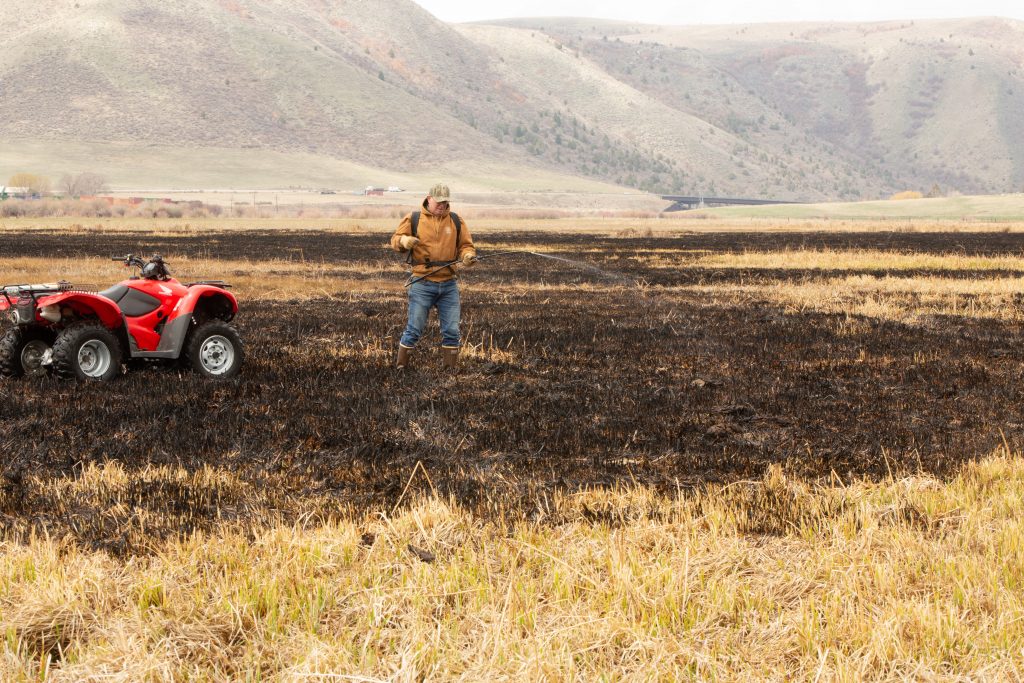Whether Spraying or Doing a Hatchet Job HEED THE LABEL
Protecting beneficial trees, shrubs and grasses is a delicate balance when managing wild turkey habitat.
While burning is important for maintaining wildlife habitat, herbicides are essential for removing sweetgum, black cherry and other fast-growing woody species when preparing a site for long-term management.
Ricky Lackey, NWTF district biologist for Florida, Georgia and South Carolina, said that applying herbicides is a straightforward process if you follow directions on the labels of the herbicides you select.
“Probably the mistake that a lot of people make would be using too much of it,” Lackey said. “They might think that a higher rate would get better control, and sometimes that’s not the case.”
Triclopyr will knock back a mid-story overgrowth of broad-leafed, woody growth. It’s available under many brand names. A broadcast treatment will affect grasses and forbs, Lackey said, but precise impact practices like hack-and-squirt or stump applications will limit its impact almost entirely to the targeted vegetation types.
“Even a broadcast application, if you’re not getting it in the understory, is not going to hurt grasses,” Lackey said, “but it will treat the waxy, woody broadleaf trees and shrubs you’re trying to control.”
If you are treating a food plot or an old field site, there are grass-specific herbicides appropriate for that situation, Lackey said.
A novice might generically apply a product like Roundup based on name recognition and reputation. Though effective in proper context, Roundup and others can be counterproductive if applied in broadcast fashion.
“You certainly don’t want to do that with Roundup because it will kill everything,” Lackey said. “Spray the right chemical at the appropriate level for the objective you’re trying to reach. The instructions are right on the label.”
Hatchet Jobs
It’s hard to bungle a hack-and-squirt project, Lackey said, unless you aren’t aggressive enough. Hack-and-squirt is a basic herbicide application method that applies herbicide into the stem (trunk) and is used to target specific undesirable trees.
“If you’ve got the right chemical, just put a hack (usually with a hatchet into the vascular cambium wood) into the side of the tree and spray herbicide into the exposed tissue,” Lackey said. “I don’t know that I’ve ever seen any type of hack-and-squirt project that was done wrong unless it just wasn’t completed.”

J.D. Neeley, president of Neeley Forestry Services of Camden, Arkansas, and a member of the Arkansas Game and Fish Commission, said that preparing a management site is essential to success. Sea myrtle and other waxy plants require extra herbicide, Neeley said, but you have to knock them out early, before pines are in place.
Both Neeley and Lackey caution against using herbicides that leach into the soil and are taken up by desirable vegetation.
“Imazapyr products are soil reactive,” Neeley said. “You can have leaching. If you apply herbicide too close to a streamside management zone or a buffer zone where you’ve got nice hardwoods, soil activity is going to move that product down into that streamside zone a little bit. You can see some hardwoods die if you apply herbicide too close. It might have fallen just the way the applicator wanted it to, but it moved in the soil or water about 30 feet. We caution all of our applicators to buffer 60 feet off those streamside zones.”
If you prep and maintain your site properly, Neeley said, turkeys will reward your efforts.
“It’s really all upside because turkeys respond well to vegetation control,” Neeley said. “You’ll have good herbaceous growth come in behind it, the forbs, grasses, all that kind of stuff. Thinning, spraying and burning are the best things we can do to create and maintain good forest habitat.”
